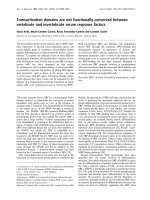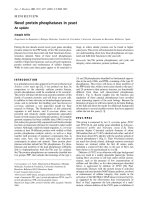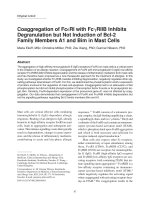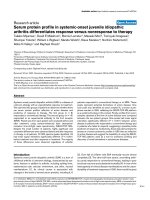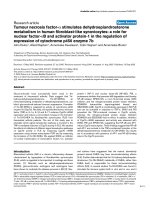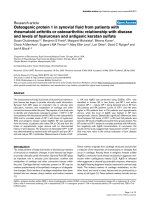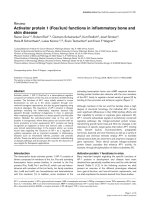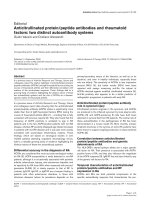Báo cáo y học: " C-reactive protein does not opsonize early apoptotic human neutrophils, but binds only membrane-permeable late apoptotic cells and has no effect on their phagocytosis by macrophages" pot
Bạn đang xem bản rút gọn của tài liệu. Xem và tải ngay bản đầy đủ của tài liệu tại đây (1.03 MB, 8 trang )
BioMed Central
Page 1 of 8
(page number not for citation purposes)
Journal of Inflammation
Open Access
Research
C-reactive protein does not opsonize early apoptotic human
neutrophils, but binds only membrane-permeable late apoptotic
cells and has no effect on their phagocytosis by macrophages
Simon P Hart*, Karen M Alexander, Shonna M MacCall and Ian Dransfield
Address: MRC Centre for Inflammation Research, University of Edinburgh Medical School, Teviot Place, Edinburgh EH8 9AG, UK
Email: Simon P Hart* - ; Karen M Alexander - ; Shonna M MacCall - ;
Ian Dransfield -
* Corresponding author
Abstract
Background: It has been reported that C-reactive protein (CRP) binds both leukocyte FcγRIIA
(CD32) and the plasma membrane of apoptotic cells. Since FcγRIIA becomes functionally enabled
during neutrophil apoptosis, we sought to determine whether CRP bound to apoptotic neutrophils
via FcγRIIA.
Methods: We prepared directly labelled CRP and demonstrated that it was essentially free of IgG.
We looked for evidence of CRP binding to intact, membrane impermeable apoptotic human
neutrophils and to FcγRIIA-transfected Jurkat cells. We examined the functional consequences of
incubation with CRP upon phagocytosis of apoptotic cells by human monocyte-derived
macrophages.
Results: We could not detect binding of purified soluble CRP to classical early apoptotic human
neutrophils or to FcγRIIA-transfected Jurkat cells. In contrast, membrane-permeable late apoptotic
neutrophils exhibited strong CRP binding, which comprised both Ca
2+
-dependent and heparin-
inhibitable Ca
2+
-independent components. However, there was no effect of CRP binding upon
phagocytosis of late apoptotic neutrophils by macrophages.
Conclusion: Potential apoptotic cell opsonins such as CRP may bind only to intracellular
structures in cells with leaky membranes that have progressed to a late stage of apoptosis.
Background
In acute inflammation huge numbers of neutrophils are
recruited to sites of tissue injury where they die by under-
going apoptosis [1]. Macrophage clearance of apoptotic
neutrophils has been studied extensively under serum-
free conditions in vitro, but the presence of opsonins in
the inflammatory milieu means it is unlikely that "naked"
apoptotic cells would be encountered by macrophages in
vivo [2]. We have recently reported that IgG-containing
immune complexes bound preferentially to functionally
enabled FcγRIIA (CD32) on apoptotic neutrophils [3,4]. It
has been proposed that FcγRIIA is also a receptor for the
pentraxin C-reactive protein (CRP) [5,6], serum concen-
trations of which may increase more than 1000-fold dur-
ing acute inflammation [7,8]. Independently, it was
reported that soluble CRP opsonised apoptotic Jurkat cells
in vitro [9-11]. In the present study we sought to determine
whether binding of CRP to apoptotic neutrophils was
Published: 31 May 2005
Journal of Inflammation 2005, 2:5 doi:10.1186/1476-9255-2-5
Received: 25 October 2004
Accepted: 31 May 2005
This article is available from: />© 2005 Hart et al; licensee BioMed Central Ltd.
This is an Open Access article distributed under the terms of the Creative Commons Attribution License ( />),
which permits unrestricted use, distribution, and reproduction in any medium, provided the original work is properly cited.
Journal of Inflammation 2005, 2:5 />Page 2 of 8
(page number not for citation purposes)
mediated by FcγRIIA. To circumvent the inherent difficul-
ties in interpreting the results of antibody binding to Fc
receptor-bearing cells, we used directly fluorescein-conju-
gated purified CRP that was essentially free of contaminat-
ing IgG.
Methods
Conjugation of CRP with FITC
1 mg of CRP purified from human plasma (Sigma; Poole,
UK) was dissolved in 1 ml deionised water and dialysed
against 100 mM sodium bicarbonate pH 8.25. Fluorescein
isothiocyanate (FITC; Sigma) was dissolved at 1.5 mg/ml
in DMSO and added dropwise to a total volume of 45 µl
per ml of protein solution. The mixture was incubated for
2 hours at room temperature in the dark. Unconjugated
FITC was removed by exhaustive dialysis.
Assessment of CRP purity
Native and FITC-conjugated CRP were examined under
denaturing conditions on a 9% acrylamide gel stained
with Coomassie blue. Contamination with human IgG
was assessed by comparing Western blots of CRP with
known amounts of human IgG (Sigma). Blots were
probed with rabbit F(ab')
2
anti-human IgG followed by
peroxidase-conjugated goat anti-rabbit IgG (DakoCyto-
mation; Ely, UK) and developed by enhanced chemilumi-
nescence (Amersham).
CRP phospholipid binding assay
One micrometer diameter polystyrene microspheres
(Polysciences; Warrington, PA) were coated with 1 mg/ml
phosphorylcholine-conjugated BSA (Biosearch Technolo-
gies; Novato, CA) or BSA (Sigma) in PBS for 1 h at room
temperature. Beads were washed and incubated with
FITC-conjugated CRP in the presence of 2 mM Ca
2+
or 5
mM EDTA. FITC-CRP binding was measured by gating on
single beads and analysing fluorescence in the FL1 chan-
nel (530 nm) following excitation with an argon laser at
488 nm in a BD FACSCalibur flow cytometer (BD Bio-
sciences, Cowley, Oxford, UK).
CRP binding assay
Human neutrophils were isolated from peripheral blood
of healthy volunteers by dextran sedimentation and dis-
continuous Percoll gradient centrifugation [12]. Genomic
DNA extraction and determination of the polymorphism
at position 519 in exon 4 of the FcγRIIA gene was per-
formed as previously described [3]. G or A at position 519
leads to either an arginine (R) or histidine (H) amino acid
at position 131 in the second Ig-like domain of the
FcγRIIA protein. Experiments were performed using cells
from donors with each of the genotypes R/R, R/H, and H/
H. Neutrophils were aged in culture for 20 h at 37°C/5%
CO
2
in Iscove's medium (Invitrogen, Paisley, UK) con-
taining 10% autologous serum or FCS. Jurkat cells trans-
fected with human FcγRIIA or control vector were kindly
provided by Dr. Eric Brown, University of California, San
Francisco, USA [13]. Surface phenotyping using indirect
immunofluorescence and flow cytometry confirmed
expression of FcγRIIA by the transfected cells, but no
expression of FcγRI or FcγRIII was detected. Control Jurkat
cells transfected with empty vector did not express any Fc
receptors. Cells were washed twice in PBS prior to use.
Cell binding assays were performed in 140 mM NaCl pH
7.4, 20 mM HEPES, and either 2 mM CaCl
2
or 5 mM
EDTA. FITC-CRP was incubated with cells for 30 minutes
on ice, then washed twice in binding buffer and incubated
with phycoerythrin-conjugated Annexin V (Caltag;
Towchester, UK) or 5 µg/ml propidium iodide. In some
experiments cells were incubated with 1 mg/ml unfrac-
tionated heparin (Sigma) and washed twice prior to incu-
bation with FITC-CRP. Fluorescence was analysed on an
Coulter Epics XL flow cytometer (Beckman Coulter, High
Wycombe, UK) and/or a BD FACSCalibur flow cytometer.
Immunofluorescence microscopy
Aged neutrophils were labelled with 50 µg/ml FITC-CRP,
fixed in 3% paraformaldehyde, permeabilised with 0.1%
Triton X-100, counterstained with TO-PRO-3 (Molecular
Probes, Leiden, NL), and cytocentrifuged onto glass slides.
Visualisation was performed with a Leica TCSNT confocal
system (Leica Microsystems, GmBH, Mannheim,
Germany).
Flow cytometric cell sorting
Cultured human neutrophils were labelled with 25 µg/ml
FITC-CRP and sorted according to FL1 signal intensity
using a BD FACSVantage fluorescence activated cell sorter
(FACS). Sorted cell populations were checked for purity
by flow cytometry, and cell morphology was examined on
May-Giemsa-stained cytocentrifuge preparations.
Macrophage phagocytosis of late apoptotic neutrophils
Human neutrophils were labelled with CFDA (Cell-
Tracker™Green; Molecular Probes) and incubated at 37°C
for 72 h in Iscove's medium containing 10% autologous
serum to yield a cell population that contained >70% late
apoptotic neutrophils. Aged neutrophils were washed,
and incubated with 100 µg/ml CRP or Iscove's medium
alone for 30 minutes. Monolayers of 5–8d old human
monocyte-derived macrophages in 48 well plates were
incubated with 2 × 10
6
aged neutrophils in Iscove's
medium in the absence of serum for 60 minutes at 37°C
[14]. The supernatant was aspirated and the macrophages
were detached by brief incubation in 0.05% trypsin-
0.02% EDTA (Invitrogen) and vigorous pipetting. The
percentage of macrophages that had ingested one or more
apoptotic neutrophils was determined by flow cytometric
analysis as previously described [15].
Journal of Inflammation 2005, 2:5 />Page 3 of 8
(page number not for citation purposes)
Statistical analysis
Results are presented as mean ± SEM of at least three inde-
pendent experiments using cells from different donors.
Results were compared using either a paired t-test or
repeated measures ANOVA and Tukey-Kramer multiple
comparisons test as appropriate, using GraphPad InStat
version 3 (GraphPad Software, San Diego, CA).
Results
Purity and functional integrity of FITC-conjugated CRP
Binding studies were performed with human plasma-
derived CRP that had been directly conjugated to FITC.
Native CRP and FITC-CRP migrated as single bands when
examined by SDS-PAGE (Figure 1a). Western blotting
demonstrated <0.1% contamination of our CRP prepara-
tion with human IgG. (Figure 1b). FITC-CRP was shown
to be functionally active by demonstrating Ca
2+
-depend-
ent binding to phosphorylcholine-coated beads (Figure
1c). Similarly, FITC-CRP bound strongly to cells that had
been rendered necrotic by freeze-thawing (Figure 1d).
CRP does not bind to early apoptotic neutrophils
Early apoptotic neutrophils were identified within a pop-
ulation of cultured human neutrophils by their character-
istic flow cytometric laser scatter properties, labelling with
annexin V, and exclusion of propidium iodide. We found
no detectable binding of CRP at concentrations up to and
including 100 µg/ml, in presence or absence of 2 mM Ca
2+
(Figure 2). The highest concentration of CRP that we used
is comparable to serum concentrations recorded during
an acute inflammatory response. The lack of CRP binding
was observed regardless of FcγRIIA genotype (data not
shown).
Lack of binding of CRP to Fc
γ
RIIA
The lack of binding of CRP to non-apoptotic or apoptotic
neutrophils suggested that soluble (non-aggregated) CRP
was unable to bind to FcγRIIA with significant affinity. For
confirmation, Jurkat cells transfected with human FcγRIIA
were incubated with FITC-conjugated CRP. There was no
evidence of preferential binding of CRP to FcγRIIA-trans-
fected cells compared with those transfected with control
vector (Figure 3).
CRP binds strongly to a subpopulation of cultured human
neutrophils
A subpopulation of strongly positive cells was apparent
when FITC-CRP binding to ungated cultured neutrophils
was analysed. These cells were also positive for annexin V
and propidium iodide staining (Figure 4a). Similar results
were seen with human peripheral blood lymphocytes that
had been induced to undergo apoptosis by exposure to
ultraviolet radiation (data not shown). Immunofluores-
cence microscopy of cultured human neutrophils revealed
strong CRP binding to cells that had very little or no resid-
ual nuclear staining (Figure 4b). In keeping with the flow
cytometric data, there was no detectable binding to classi-
cal early apoptotic neutrophils or to non-apoptotic neu-
trophils. To confirm the morphology of the CRP-positive
cells, cultured human neutrophils were incubated with
FITC-CRP and sorted in a fluorescence-activated cell sorter
(FACS). Light microscopic examination of both cell pop-
ulations confirmed that the CRP
high
cells were "ghosts"
with little or no evidence of nuclear staining, whereas the
CRP
low
cells comprised a mixture of non-apoptotic and
early apoptotic neutrophils (Figure 4c). The CRP
high
neu-
trophils appear to have progressed to a late stage of apop-
tosis and undergone "nuclear evanescence" [16,17].
Mechanism of CRP binding
CRP binding to phospholipids is dependent on the pres-
ence of calcium ions [18], whereas binding to polycati-
onic sites is Ca
2+
-independent [19]. To determine whether
Ca
2+
was required for CRP binding to late apoptotic neu-
trophils we compared FITC-CRP binding in the presence
of 2 mM Ca
2+
and 5 mM EDTA. In the presence of EDTA,
CRP binding was reduced by approximately 50% com-
pared with total CRP binding seen in the presence of Ca
2+
(Figure 5). Because it has been reported that heparin binds
to necrotic Jurkat cells [20], we sought to identify whether
heparin and CRP bound to similar intracellullar sites. Pre-
incubation with unfractionated heparin inhibited FITC-
CRP binding to late apoptotic human neutrophils in the
presence of cations by approximately 50%, and almost
abolished residual binding when CRP was incubated in
the presence of EDTA (Figure 5), suggesting that CRP
bound to a combination of Ca
2+
-dependent and heparin-
inhibitable Ca
2+
-independent sites.
Macrophage phagocytosis of late apoptotic neutrophils
We sought to determine the effect of prior binding of CRP
on phagocytosis of late apoptotic neutrophils. Our
attempts to sort large numbers of cultured neutrophils by
FACS into early and late apoptotic populations were
unsuccessful, because during the time required for sorting
many early apoptotic neutrophils progressed to late apop-
tosis, rendering the cells unsuitable for subsequent phago-
cytosis assays. Thereafter, we prepared neutrophils
containing predominantly late apoptotic cells (>70%) by
aging neutrophils for 72 h in vitro. Prior incubation of
these late apoptotic neutrophils with 100 µg/ml CRP,
which resulted in high levels of CRP binding, had no
demonstrable effect on their phagocytosis by macro-
phages (Figure 6).
Discussion
It has been reported that the pentraxins CRP and serum
amyloid P are ligands for leukocyte Fcγ receptors [5].
FcγRIIA becomes functionally enabled on early apoptotic
human neutrophils [3,4], but we have demonstrated that
Journal of Inflammation 2005, 2:5 />Page 4 of 8
(page number not for citation purposes)
Purity and functional integrity of FITC-CRPFigure 1
Purity and functional integrity of FITC-CRP. (a) Native and FITC-conjugated CRP migrated as single bands of approxi-
mately 23 kD in SDS-PAGE. (b) Western blot of CRP and known amounts of human IgG on a 9% acrylamide gel under non-
reducing conditions. The blot was probed with anti-human IgG-HRP. CRP contained <0.1% IgG (w/w). MW markers in kDa are
illustrated. (c) FITC-CRP bound to phosphorylcholine-coated beads in the presence of 2 mM Ca
2+
(dark shaded histogram).
Binding in 5 mM EDTA (light shaded histogram) and BSA-coated beads (control; open histogram) is also shown. (d) FITC-CRP
bound to freeze-thawed necrotic neutrophils (shaded histogram). Binding of FITC-BSA is shown as a control (open histogram).
Journal of Inflammation 2005, 2:5 />Page 5 of 8
(page number not for citation purposes)
soluble CRP does not bind to classical early apoptotic
human neutrophils in vitro, and we have been unable to
demonstrate CRP binding to human FcγRIIA on trans-
fected Jurkat cells. In the present study we have been care-
ful to avoid pitfalls associated with indirect detection of
ligand binding to neutrophils by using a preparation of
directly labelled CRP that we have shown was essentially
free of contaminating IgG, but which was structurally and
functionally intact. The failure of CRP to bind FcγRIIA is
consistent with the results of Hundt and colleagues who
failed to find specific receptors for CRP on human leuko-
cytes [6].
There have been several reports of Ca
2+
-dependent opson-
isation of apoptotic cells by pentraxins [9,11,21]. The lack
of CRP binding to classical early apoptotic human neu-
trophils, which exhibit all the biochemical and surface
changes associated with apoptosis yet remain intact and
membrane impermeable, raises questions about whether
putative opsonins are really able to bind with high affinity
to apoptotic cells. In contrast, we demonstrated very
strong CRP binding to a subpopulation of aged neu-
trophils which displayed the characteristics of late apop-
totic neutrophils previously reported by Hebert [16] and
Ren [17]. It has been recognised that CRP binds to
necrotic cells since Kushner and Kaplan demonstrated
CRP deposition in necrotic skeletal muscle fibres follow-
ing typhoid vaccination in vivo [22]. It is not always recog-
nised that induction of apoptosis in many cell types in
vitro leads to a significant proportion of membrane-per-
meable late apoptotic cells [23]. The presence of leaky late
Lack of CRP binding to early apoptotic human neutrophilsFigure 2
Lack of CRP binding to early apoptotic human neutrophils. FITC-CRP binding to aged human neutrophils was assessed
by dual color flow cytometry using annexin V-PE to identify apoptotic cells. In comparison with buffer alone (a), FITC-CRP did
not bind to apoptotic neutrophils at concentrations up to 100 µg/ml (b,c).
CRP does not bind to FcγRIIAFigure 3
CRP does not bind to FcγRIIA. Jurkat cells transfected
with empty vector (-; open symbols) or human FcγRIIA (+;
closed symbols) were incubated with FITC-conjugated CRP
(circles) or FITC-BSA control (triangles). There was no dif-
frence in binding between transfected and non-transfected
cells.
Journal of Inflammation 2005, 2:5 />Page 6 of 8
(page number not for citation purposes)
CRP binds to a subpopulation of apoptotic neutrophilsFigure 4
CRP binds to a subpopulation of apoptotic neutrophils. (a) Three color flow cytometry demonstrated that FITC-CRP
(50 µg/ml) bound strongly to a subpopulation of apoptotic neutrophils that also stained with propidium iodide (PI). (b) Immun-
ofluorescence microscopy of aged human neutrophils revealed strong CRP binding (green) to a late apoptotic neutrophil
(arrow)(left panel). Nuclei have been stained with TO-PRO-3 (blue). The late apoptotic cell has almost no residual nuclear
staining (right panel). There was no detectable binding to an early apoptotic neutrophil (arrowhead) or to non-apoptotic neu-
trophils. (c) Light microscopy of CRP
high
(left panel) and CRP
low
(right panel) cells sorted by FACS from a population of aged
neutrophils illustrates the ghost-like morphology of CRP-binding apoptotic neutrophils. The CRP
low
cells comprise a mixture of
non-apoptotic and early apoptotic neutrophils.
Journal of Inflammation 2005, 2:5 />Page 7 of 8
(page number not for citation purposes)
apoptotic cell ghosts in a cell population may be
overlooked because the lack of nuclear material means
that they stain very faintly with May-Giemsa, and in the
past late apoptotic cells may have been gated out as
"debris" when analysed by flow cytometry. Furthermore,
these cells pellet poorly in cytocentrifuge preparations,
and this combined with their "invisibility" with May-
Giemsa stains means that their prevalence has been
underestimated. This clearly has implications for studies
of apoptotic cell opsonisation, and much of the published
data may reflect binding to intracellular moieties. CRP is
not unique in binding to the interior of leaky apoptotic
cells, and we have reported a similar phenomenon with
the unrelated serum protein thrombospondin [24]. Com-
plement proteins, collectins, and heparin may also bind
preferentially to late apoptotic cells [20,25,26]. The pre-
cise structures responsible for CRP binding have not been
elucidated, but our data suggest that there are both Ca
2+
-
dependent and Ca
2+
-independent binding sites. Binding
to cell membrane phospholipids may account for the
Ca
2+
-dependent component [18], whereas binding to
polycations may be responsible for the heparin-inhibita-
ble Ca
2+
-independent component [19]. The relative pau-
city of nuclear chromatin in the late apoptotic cells and
the absence of nuclear co-localisation seen with fluores-
cence microscopy means that chromatin binding is
unlikely to be responsible [21].
The presence of late apoptotic cells also has implications
for studies of the phagocytosis of apoptotic cells, since
these cells may be recognised differently from classical
early apoptotic cells [17,23]. It is not known whether
"opsonins" bound to intracellular components would be
accessible for recognition by phagocyte receptors. In the
present study we have shown that despite very strong CRP
binding to late apoptotic neutrophils, there was no detect-
able effect on their clearance by macrophages. Ren and
colleagues demonstrated that the efficiency of phagocyto-
sis of early- and late apoptotic neutrophils was similar
[17], so we think it is unlikely that an effect of CRP on
uptake of late apoptotic cells has been masked by baseline
uptake of early apoptotic neutrophils in the population of
aged cells that we used.
Conclusion
By using a directly labelled pure preparation of CRP we
have found no evidence that CRP opsonises classical early
apoptotic neutrophils in vitro. Like other proteins and sug-
ars it binds intracellularly to membrane-permeable cells,
Additive inhibition of CRP binding by EDTA and heparinFigure 5
Additive inhibition of CRP binding by EDTA and
heparin. FITC-CRP was incubated with cultured human
neutrophils in the presence of 2 mM Ca
2+
or 5 mM EDTA,
with or without pre-incubation with 1 mg/ml heparin. Binding
to late apoptotic neutrophils was assessed by gating on the
propidium iodide-positve cell population. The inhibitory
effects of EDTA and heparin on CRP binding were additive.
Macrophage phagocytosis of late apoptotic neutrophilsFigure 6
Macrophage phagocytosis of late apoptotic neu-
trophils. CRP (100 µg/ml) was allowed to bind to human
neutrophils that had been aged for 72 h (>70% late apop-
totic) prior to assessment of phagocytosis by human macro-
phages. Prior incubation with CRP had no effect on the
precentage of macrophages that phagocytosed one or more
late apoptotic neutrophils.
Publish with BioMed Central and every
scientist can read your work free of charge
"BioMed Central will be the most significant development for
disseminating the results of biomedical research in our lifetime."
Sir Paul Nurse, Cancer Research UK
Your research papers will be:
available free of charge to the entire biomedical community
peer reviewed and published immediately upon acceptance
cited in PubMed and archived on PubMed Central
yours — you keep the copyright
Submit your manuscript here:
/>BioMedcentral
Journal of Inflammation 2005, 2:5 />Page 8 of 8
(page number not for citation purposes)
but has no significant influence their subsequent phago-
cytosis by macrophages. A precise role for CRP remains to
be elucidated.
Abbreviations
CFDA, 5-chloromethylfluorescein diacetate; CRP, C-reac-
tive protein; FACS, fluorescence-activated cell sorter
Competing interests
The author(s) declare that they have no competing
interests.
Authors' contributions
SH designed the study, carried out the binding and phago-
cytosis experiments, analysed the data, and drafted the
manuscript. KA carried out the binding and phagocytosis
experiments. SM performed the cell sorting. ID partici-
pated in the design and execution of the study and drafted
the manuscript. All authors have read and approved the
final manuscript.
Acknowledgements
We are grateful to Dr. Eric Brown for providing the FcγRIIA-transfected
Jurkat cells, and to Linda Wilson for operating the confocal microscope.
This work was funded by a Medical Research Council Clinician Scientist Fel-
lowship (G108/460).
References
1. Savill JS, Fadok VA, Henson PM, Haslett C: Phagocyte recognition
of cells undergoing apoptosis. Immunol Today 1993, 14:131-136.
2. Hart SP, Smith JR, Dransfield I: Phagocytosis of opsonized apop-
totic cells: roles for 'old-fashioned' receptors for antibody
and complement. Clin Exp Immunol 2004, 135:181-185.
3. Hart SP, Jackson C, Kremmel LM, McNeill MS, Jersmann H, Alexander
KM, Ross JA, Dransfield I: Specific binding of an antigen-anti-
body complex to apoptotic human neutrophils. Am J Pathol
2003, 162:1011-1018.
4. Hart SP, Alexander KM, Dransfield I: Immune complexes bind
preferentially to FcgammaRIIA (CD32) on apoptotic neu-
trophils, leading to augmented phagocytosis by macro-
phages and release of proinflammatory cytokines. J Immunol
2004, 172:1882-1887.
5. Bharadwaj D, Stein MP, Volzer M, Mold C, Du Clos TW: The major
receptor for C-reactive protein on leukocytes is fcgamma
receptor II. J Exp Med 1999, 190:585-590.
6. Hundt M, Zielinska-Skowronek M, Schmidt RE: Lack of specific
receptors for C-reactive protein on white blood cells. Eur J
Immunol 2001, 31:3475-3483.
7. Kushner I, Gewurz H, Benson MD: C-reactive protein and the
acute-phase response. J Lab Clin Med 1981, 97:739-749.
8. Pepys MB, Hirschfield GM: C-reactive protein: a critical update.
J Clin Invest 2003, 111:1805-1812.
9. Gershov D, Kim S, Brot N, Elkon KB: C-Reactive protein binds to
apoptotic cells, protects the cells from assembly of the ter-
minal complement components, and sustains an antiinflam-
matory innate immune response: implications for systemic
autoimmunity. J Exp Med 2000, 192:1353-1364.
10. Chang MK, Binder CJ, Torzewski M, Witztum JL: C-reactive pro-
tein binds to both oxidized LDL and apoptotic cells through
recognition of a common ligand: Phosphorylcholine of oxi-
dized phospholipids. Proc Natl Acad Sci U S A 2002,
99:13043-13048.
11. Mold C, Baca R, Du Clos TW: Serum amyloid P component and
C-reactive protein opsonize apoptotic cells for phagocytosis
through Fcgamma receptors. J Autoimmun 2002, 19:147-154.
12. Dransfield I, Buckle AM, Savill JS, McDowall A, Haslett C, Hogg N:
Neutrophil apoptosis is associated with a reduction in CD16
(FcgRIII) expression. J Immunol 1994, 153:1254-1263.
13. Green JM, Schreiber AD, Brown EJ: Role for a glycan phosphoi-
nositol anchor in Fc gamma receptor synergy. J Cell Biol 1997,
139:1209-1217.
14. Hart SP, Rossi AG, Dransfield I: You can lead a macrophage to
an inflammatory site but can you make it eat? Biochem Soc
Trans 1998, 26:650-652.
15. Jersmann HP, Ross KA, Vivers S, Brown SB, Haslett C, Dransfield I:
Phagocytosis of apoptotic cells by human macrophages:
Analysis by multiparameter flow cytometry. Cytometry 2003,
51A:7-15.
16. Hebert MJ, Takano T, Holthofer H, Brady HR: Sequential morpho-
logic events during apoptosis of human neutrophils. Modula-
tion by lipoxygenase-derived eicosanoids. J Immunol 1996,
157:3105-3115.
17. Ren Y, Stuart L, Lindberg FP, Rosenkranz AR, Chen Y, Mayadas TN,
Savill J: Nonphlogistic clearance of late apoptotic neutrophils
by macrophages: efficient phagocytosis independent of beta
2 integrins. J Immunol 2001, 166:4743-4750.
18. Volanakis JE, Wirtz KW: Interaction of C-reactive protein with
artificial phosphatidylcholine bilayers. Nature 1979,
281:155-157.
19. DiCamelli R, Potempa LA, Siegel J, Suyehira L, Petras K, Gewurz H:
Binding reactivity of C-reactive protein for polycations. J
Immunol 1980, 125:1933-1938.
20. Gebska MA, Titley I, Paterson HF, Morilla RM, Davies DC, Gruszka-
Westwood AM, Kakkar VV, Eccles S, Scully MF: High-affinity bind-
ing sites for heparin generated on leukocytes during apopto-
sis arise from nuclear structures segregated during cell
death. Blood 2002, 99:2221-2227.
21. Familian A, Zwart B, Huisman HG, Rensink I, Roem D, Hordijk PL,
Aarden LA, Hack CE: Chromatin-independent binding of
serum amyloid P component to apoptotic cells. J Immunol
2001, 167:647-654.
22. Kushner I, KAPLAN MH: Studies of acute phase protein. I. An
immunohistochemical method for the localization of Cx-
reactive protein in rabbits. Association with necrosis in local
inflammatory lesions. J Exp Med 1961, 114:961-974.
23. Devitt A, Pierce S, Oldreive C, Shingler WH, Gregory CD: CD14-
dependent clearance of apoptotic cells by human macro-
phages: the role of phosphatidylserine. Cell Death Differ 2003,
10:371-382.
24. Hart SP, Ross JA, Ross K, Haslett C, Dransfield I: Molecular char-
acterization of the surface of apoptotic neutrophils: implica-
tions for functional downregulation and recognition by
phagocytes. Cell Death Differ 2000, 7:493-503.
25. Gaipl US, Kuenkele S, Voll RE, Beyer TD, Kolowos W, Heyder P, Kal-
den JR, Herrmann M: Complement binding is an early feature
of necrotic and a rather late event during apoptotic cell
death. Cell Death Differ 2001, 8:327-334.
26. Nauta AJ, Raaschou-Jensen N, Roos A, Daha MR, Madsen HO, Bor-
rias-Essers MC, Ryder LP, Koch C, Garred P: Mannose-binding lec-
tin engagement with late apoptotic and necrotic cells. Eur J
Immunol 2003, 33:2853-2863.

